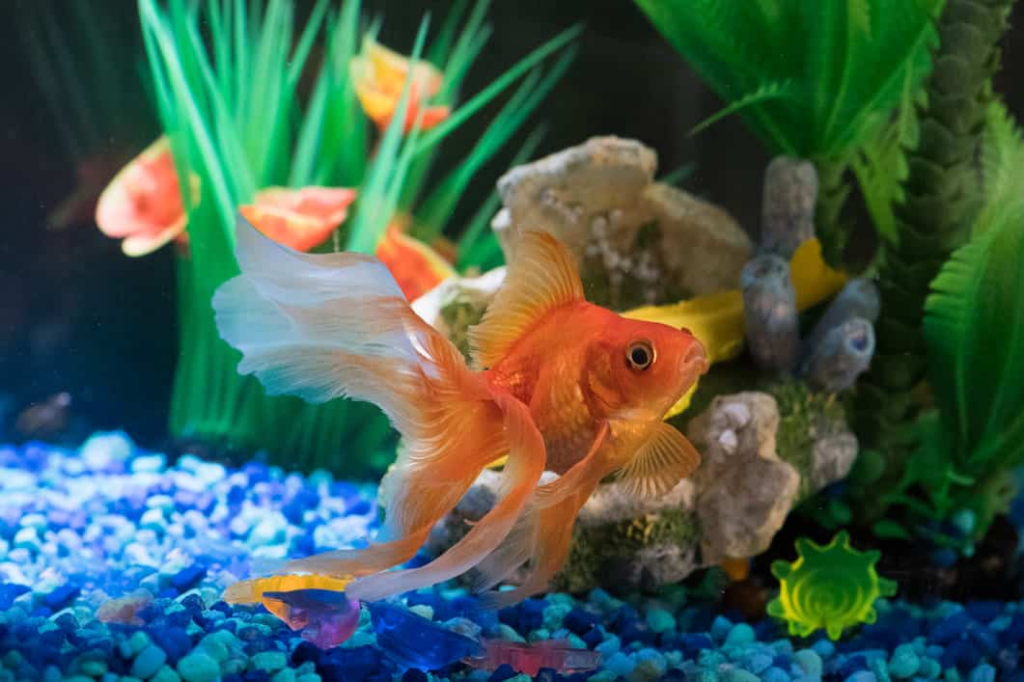
Splish, splash! We’re about to dive deep into the world of aquarium live plants. Expect tales of Anubias Nana’s tenacity, Java Fern’s joy, Amazon Sword’s allure, and much more.
But we won’t just be speaking in pretty adjectives. We’ll balance our journey with some clear-eyed reviews. We’ll dish out the pros, the cons, and sift through the sea of customer reviews. So what say you, ready to have a whale of a time with aquatic greenery?
Anubias Nana
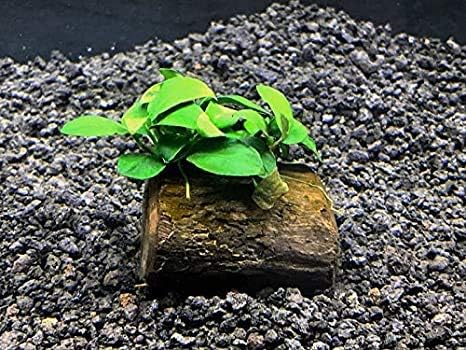
First on our list is the trusty Anubias Nana. This hardy little plant is perfect for a goldfish tank. It’s petite, stout and evergreen with shiny, vibrant leaves that provide shelter and entertainment for your goldfish.
Pros:
One of the major perks of Anubias Nana is its hardiness. It can thrive in low light and doesn’t require CO2 injection. Plus, it’s great for beginners. Did I mention it’s also a slow grower? So, say goodbye to excessive pruning sessions.
Cons:
On the flip side, this plant’s slow growth rate may not meet everyone’s needs, and goldfish might nibble on it occasionally. But don’t worry, it’s tough enough to withstand a little goldfish chomping.
Customer Reviews
Customers are generally singing the praises of Anubias Nana. The plant is widely known for its durability, low maintenance, and charm in a goldfish tank. Some even reported their goldfish enjoying a game of hide-and-seek within its foliage!
As we say bon voyage to Anubias Nana, we’re cruising to the land of the Java Fern. Hailed by many as a great addition to goldfish tank due to its impressive characteristics, let’s dive into the deets and see what makes this plant rise above the rest.
Java Fern (Leptochilus Pteropus)
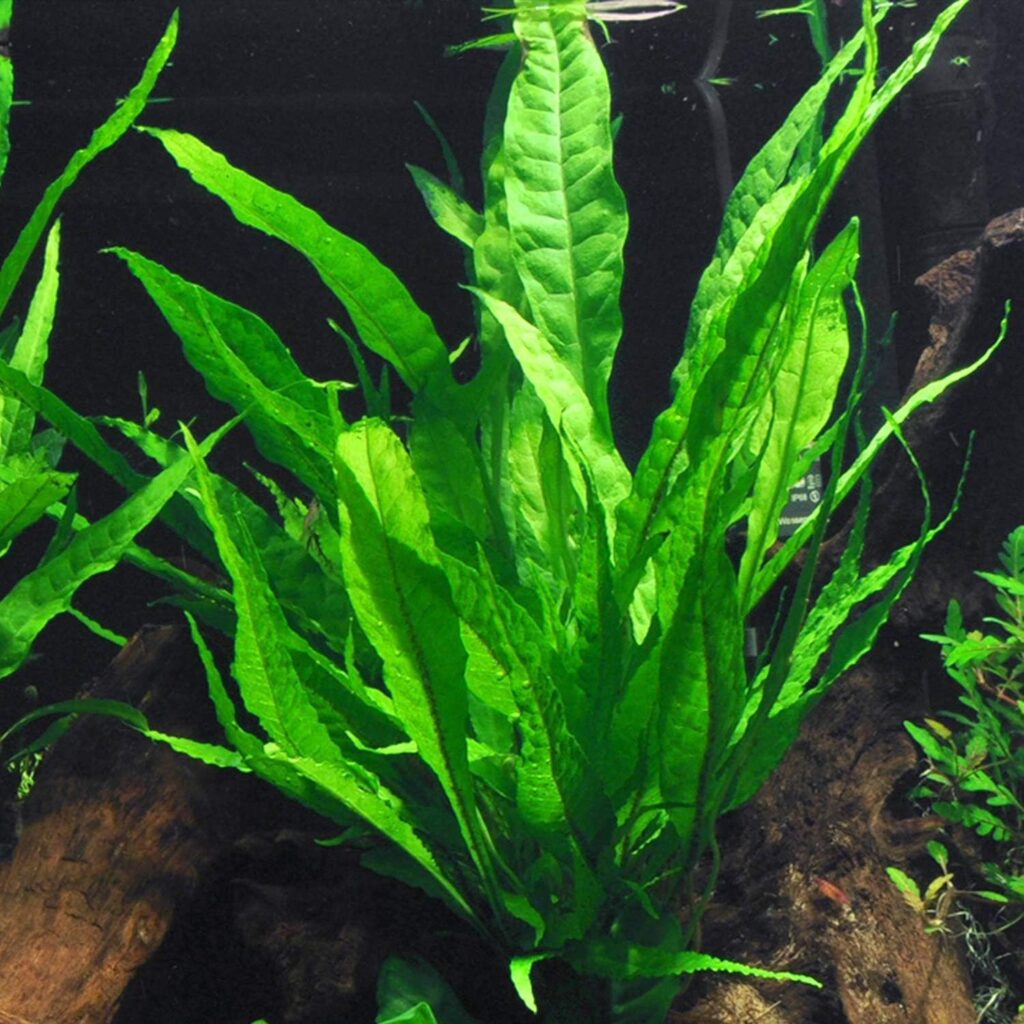
Meet the Java Fern, Mother Nature’s underwater multitasker. Decked out in deep-forest green, it’s as stylish as your IKEA houseplant. But there’s more – it blooms in low light and doesn’t demand your constant care. Just sling it to a rock or driftwood, and watch it go ‘Aquaman.’
Pros:
The Java fern is the envy of all goldfish. Why? First, it’s underwater-marathon-ready, surviving longer submerged than most. Second, it’s like the Superman of aquatic plants; low light, changing conditions, it takes it all in stride.
Cons:
But no plant is perfect. Our Java friend, though low maintenance, dislikes being buried in substrate. If you insisted, it would pout—and by pout, I mean rot. Plus, it’s a slow grower. If you’re hoping for an aquatic jungle overnight, you might be left high and dry.
Customer Reviews
Customers dub the Java Fern as ‘Nature’s Underwater Wonder,’ bearing witness to its hardiness and versatility. Some though, secretly wish that they had a ‘fast-forward’ button to speed its growth.
And that’s our Java Fern; a low maintenance, slow growing, survivor in the underwater kingdom. With this fern, your fish gets a new plant buddy and you won’t have any living-room-plant-rescue-missions. Now, let’s dive on to our next aquatic superstar.
Amazon Sword (Echinodorus grisebachii)

Meet our third contestant, the Amazon Sword! This plant towers like a skyscraper in your aquarium. With leaves that have a slight wave, they replicate an underwater greenery dream. Amazon Swords can grow up to 20 inches tall, making them perfect for large aquariums. Their robust root system synergizes well with goldfish as they love to play and munch on roots.
Pros:
You’ll love the forgiving nature of Amazon Sword. It’s durable, requires minimal light, and tolerates a wide range of water conditions. Furthermore, its thick foliage is excellent for goldfish to hide and play. The best part? It provides a feast with its edible leaves.
Cons:
Yet, there’s no such thing as a perfect plant, and it goes for the Amazon Sword too. It demands a nutrient-rich substrate for optimal growth. Plus, its formidable size might dwarf smaller goldfish tanks.
Customer Reviews
Customers often highlight the Amazon Sword’s durability and benefit of being an edible “toy” for goldfish. They appreciate its hardy nature and how it uplifts the aquarium’s aesthetics. However, a few customers have expressed their concerns over its size.
The Amazon Sword might not fit into everyone’s tank, but it certainly leaves a strong impression! Now, let’s dive deeper and discover our fourth plant, the versatile Hornwort.
Hornwort (Coontail)

Say howdy to Hornwort! An evergreen superstar in the aquatic world. With its feathery, dense foliage and uncomplicated nature, it’s a favorite among fish keepers. A bold green, it grows both floating and rooted.
Pros:
First of all, this little champ is almost indestructible. Ever tossed your laundry in the washer and forgotten about it? Fear not! Hornwort can handle a wide range of conditions. As a bonus, its growth rate is impressive. Faster than a toddler spotting an open candy jar.
Cons:
While Hornwort is busy being super adaptable, it’s often a little too excited about shedding needles. But honestly, who can resist a good shed after a growth spurt? The needles can mess up your tank a bit, but it’s nothing a little clean-up can’t handle.
Customer Reviews
Folks who’ve gotten up close and personal with Hornwort rave about its relentless growth. It’s like that friendly neighbor who never declines a BBQ invite. Some folks find the shedding component a hassle, but the majority have shrugged it off as easy-peasy cleaning.
Are you ready for more? Let’s dive into the next aquatic star that your Goldfish would surely love to get chummy with. Got your snorkels ready? We’re heading for a frolic with the Water Wisteria!
Water Wisteria (Hygrophila Difformis)

Water Wisteria is the Beyoncé of water plants- a real showstopper plants! This fantastic foliage stands tall like a diva with beautiful, bright leaves branching in different angles. Hailing from the Indian subcontinent, it’s a real tropical treat and versatile performer in aquariums.
Pros:
This superstar doesn’t just sing, it shines with benefits! It’s hardy and fast-growing, perfect if you’re a plant stage manager with not much time on your hands. And when it comes to goldfish, this superstar provides terrific shelter and even helps curb that pesky algae growing on your aquarium’s precious glass stage.
Cons:
Like a diva though, the Water Wisteria can become a bit demanding. It may require added nutrients to achieve maximum blooming beauty. Also, it can grow quite tall, which might steal the limelight from your goldfish if pruned improperly.
Customer Reviews
Most aquarium maestros gush about the Water Wisteria’s dynamic performance in their set-ups, but a few customers have bemoaned some diva demands.
Before the curtain drops on this segment, let’s float on to the next species. Coming up is a plant so popular, you’d think it was selling out stadiums. Get ready to meet the superstar of the water plant world, the Duckweed.
Duckweed
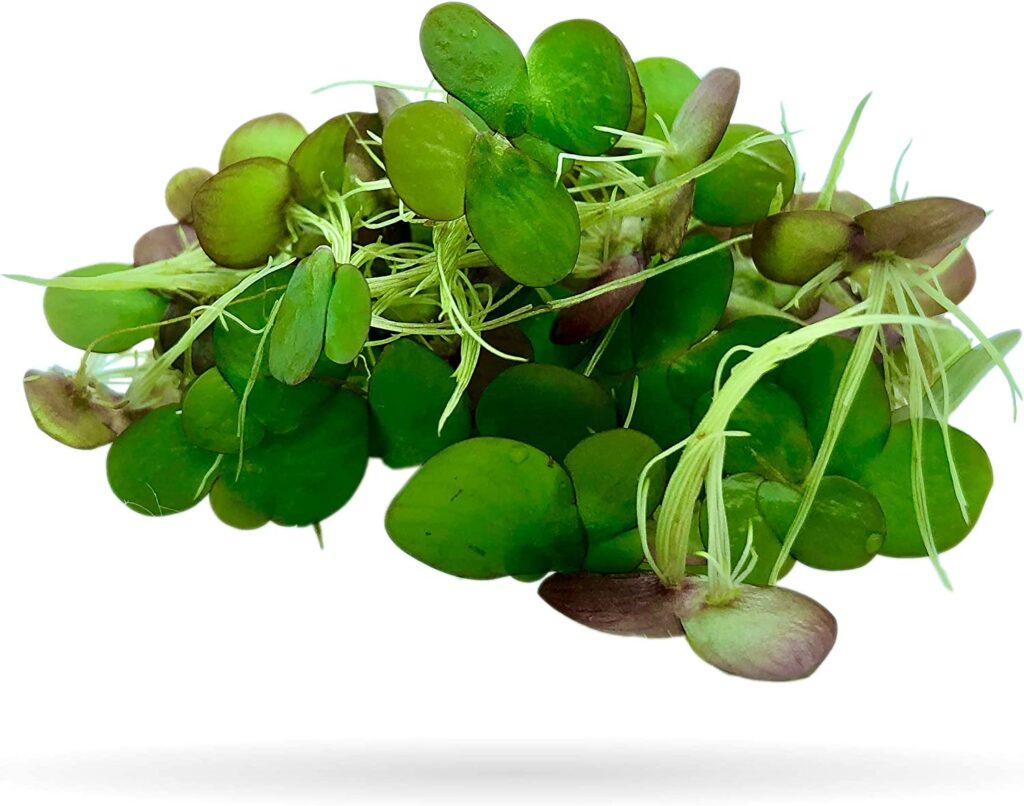
Quack quack! Alright, it’s not actually for ducks, but a goldfish aquarium sure loves it. Duckweed, a tiny floating plant, is a fun addition to any fish tank. It resembles a mini water lily from afar. It’s fast-growing and hardy, perfect for goldfish who have a reputation for being a bit plant-nippy.
Pros:
This natural water purifier is not just tolerable, but beneficial to your goldfish. It reduces harmful nitrates, provides cover, and even serves as a tasty snack. Now who doesn’t love a greenery that multitasks?
Cons:
But hold up, this little green buddy can sometimes play too hard. It multiplies like crazy creating a dense mat which can block light for other plants. And for those of you who prefer a spotless aquarium, beware, duckweed is a mess-maker.
Customer Reviews
Real life goldfish keepers adore duckweed. They applaud its benefits of purifying water and providing a snack route to their pets. Despite its messy reputation and the occasional black-out, it’s still loved for its multitasking skills.
And that, ladies and gents, is the mighty mite, duckweed. But let’s move on now to an aquarium plant that turns your goldfish’s home into a green world wonder – the mystical Marimo Moss Balls.
Marimo Moss Balls
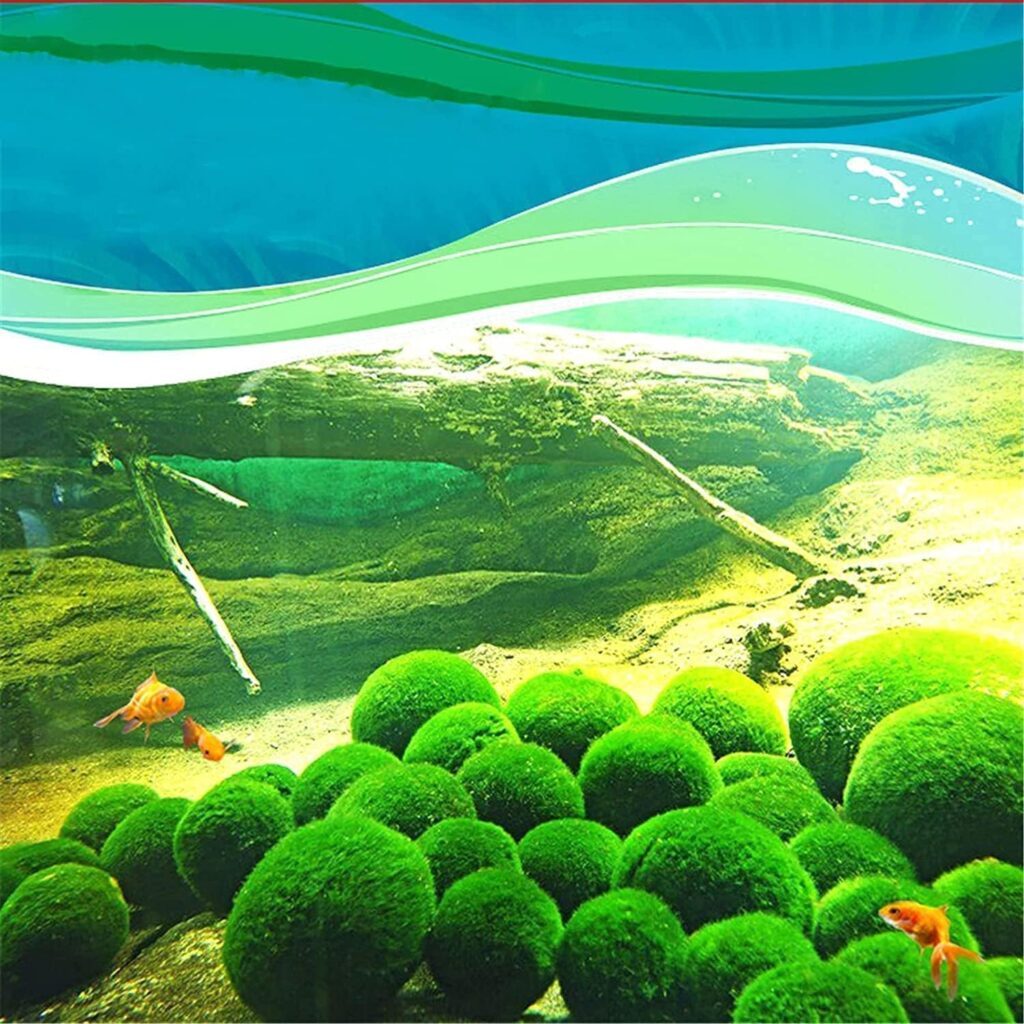
Say hello to our round and dodgy friend, Marimo Moss Balls. These aren’t your typical ‘ball’ games – don’t kick them! They’re rare aquatic plants native to Japan. Marimos look just like fuzzy green golf balls and are easy to maintain. No need for a green thumb here.
Pros:
Who doesn’t love something low-maintenance? These little guys grow slowly, don’t need much light, and are as chill as cucumbers when your goldfish play bumper cars with them. Plus, they pull double duty – they absorb nitrates while giving your aquarium an aesthetic upgrade with their lovely green hue.
Cons:
It’s not all a bed of roses, though. These cute balls might surprise you – they love cooler water. So, if your aquarium turns into a hot tub, you may need to move your Marimos elsewhere. Also, they require a gentle squeeze during water changes to clean them. Yes, even moss balls need a bath now and then!
Customer Reviews
In general, customers are rolling around with happiness for their Marimos. They mention that these unusual plants add a quirky charm to their aquariums. But perhaps more importantly, they play a key role in maintaining a healthy balance in the ecosystem, acting like silent ninjas against unwanted nitrates.
So that was all about our round friend, Marimo Moss Ball. Movement and grace – that’s our next plant’s forte. Next up, we dive into the underwater world of Ludwigia Repens. Let’s witness how they bring beauty and color to our goldfish’s underwater paradise.
Ludwigia Repens

Ready to add a pop of color to your aquarium? Ludwigia Repens, or as I like to call it, the drama queen of goldfish aquariums, might be the showstopper you’re seeking. A versatile, fast-growing plant, it arrives to the aquatic party with leaves shining in shades of red, green, and gold. Breath-taking, isn’t it? This ostentatious beauty grows both submersed and immersed, adapting to various water conditions.
Pros:
Our friend Ludwig is pretty laid back about light conditions, happy in moderate to high lighting. A bonus? It’s a reputed oxygenator, making your goldfish’s home even more breathable. Not to mention, its fast growth can combat unwanted algae by absorbing excess nutrients.
Cons:
Ludwigia Repens’ beauty isn’t without a price. This dramatic diva has been known to shed its lower leaves if the lighting isn’t to its liking. Also, with rapid growth, comes the need for persistent pruning to avoid Ludwig taking over the aquarium’s spotlight.
Customer Reviews
Most customers rave about Ludwigia Repens’ stunning visual impact. Its multi-coloured glow makes it a fan favorite. However, some aquarists find the pruning commitment a bit daunting, and there’s that leaf-shedding issue. But hey, every star has its quirks, right?
Thought Ludwigia was dramatic? Brace yourself, we’re diving into the world of Vallisneria next! A plant with its own underwater charm and unique set of attributes. So, hold your breath, we’re going deeper!
Vallisneria

Vallisneria, fondly known as “Val”, by aquarium aficionados worldwide, is an underwater superstar. It’s a freshwater plant that waves its long, tape-like leaves as if it’s trying to high-five your goldfish. This easy-to-care plant can grow in nearly any type of water condition, making it a hot favorite among novice fish keepers.
Pros:
These aquatic plants are like your grandma’s tomato patch, you ignore it and it grows six foot tall! It’s perfect for goldfish because it’s sturdy and has a strong tolerance. If your goldfish decide to play ‘Bulldozer’, this valiant plant won’t budge, surviving the goldfish shenanigans. It helps in stabilizing the water chemistry, acting like a gentle, nurturing nanny for your aquatic pets.
Cons:
Although resilient, Vallisneria is not invincible. A real con to consider is that under less ideal conditions, this plant can take a longer time to establish itself. Another drawback is its rapid growth; you might find yourself engaged in an underwater lawn-trimming regime more frequently than you bargain for!
Customer Reviews
Clocking an average of 4.7 stars out of 5, customers often praise Vallisneria for its hardiness and ability to create dense ‘fields’, providing secure hideaways for their goldfish. However, a few users pointed out their battle with runaway Vallisneria growth, marking it as a potential aqua-grocery.
Well, folks, that wraps up Vallisneria. If you don’t mind an aquatic plant version of the “Fast & Furious”, get ready to witness a beautiful underwater meadow in your tank. But hold on to your nets, we still have one more green contestant to go. Dive into our next aquatic jewel, the Water Sprite.
Water Sprite (Ceratopteris Thalictroides)
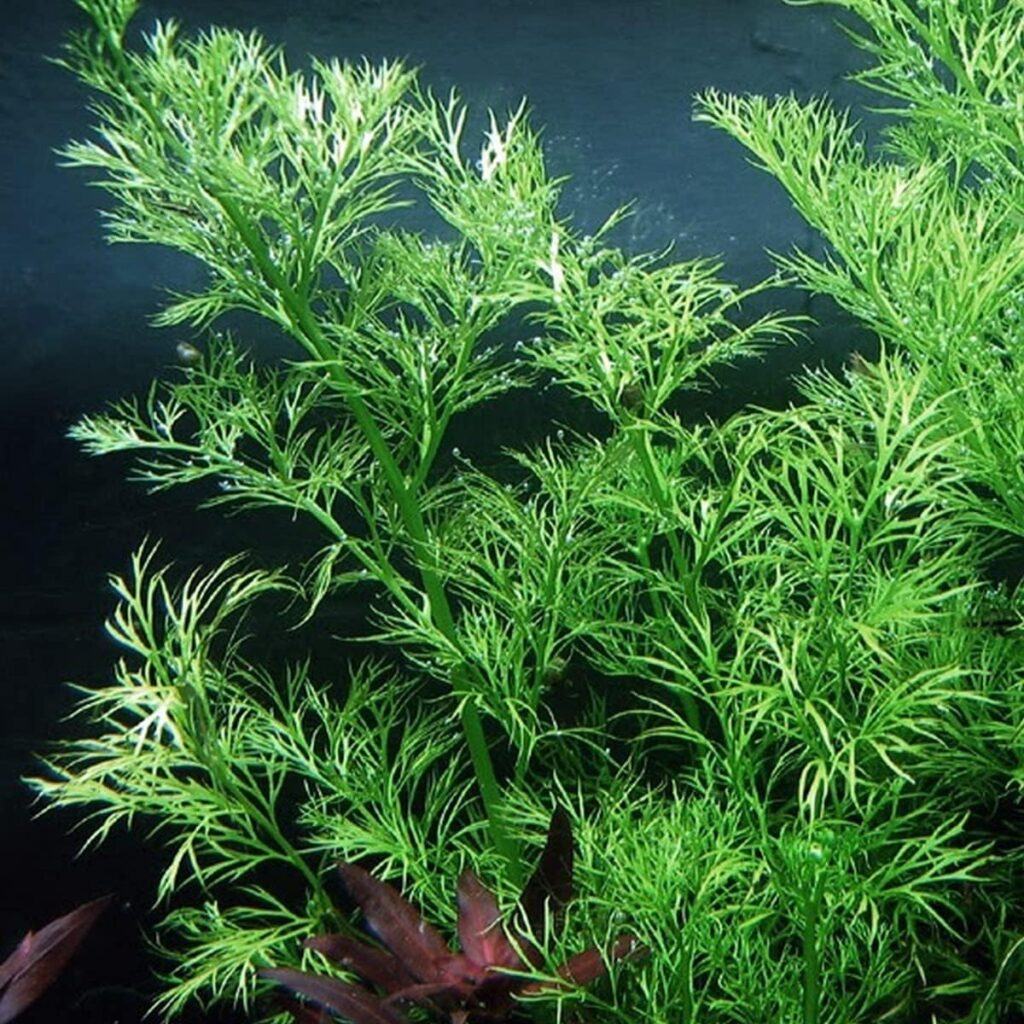
If we were searching for a goldfish’s best friend in the plant world, Water Sprite might just be it. As a fast-growing floating or rooted plant, it’s not only pretty to look at, but it also provides excellent covering and hiding spots for your goldfish! Think of it as a goldfish’s secret trail hiding in plain sight within the aquarium.
Pros:
If your goldfish could talk, they would tell you that they adore their leafy roomie – the Water Sprite. Firstly, its bright green, fern-like leaves create a stunning, lush backdrop in any aquarium. Secondly, it helps keep water quality in check by taking in excess nutrients, keeping that annoying algae at bay. A handy plant-sidekick, wouldn’t you say?
Cons:
But alas, not all is rosy in the Water Sprite universe. As with any plant, it needs a moderate amount of light, so you can’t entirely rely on the subdued glow of your room lamp. Moreover, its rapid growth can sometimes get a little out of hand. Maintaining a balanced Water Sprite population might be your next hobby!
Customer Reviews
Flip through the fan letters for the Water Sprite, and you’ll find a familiar theme. Aquarists gush over its quick growth and decorative flair. It’s like having a mini Amazon rainforest right in your living space. However, there are a few who express their struggles with the plant’s habit of hogging space if unchecked. Well, as they say, you can’t win ’em all!
To Sum Up
Before we sign off, give yourself a pat on the back for giving your goldfish the rich, leafy environment they thrive in. And remember, the next time your goldfish wiggles its fins at you, it might just be whispering a thank you for the lovely leafy shades and hiding spots!
In this aquatic plant world, each breed holds its own charm. The Anubias Nana and Java Fern provide sturdiness with a delightfully lush display. The Amazon Sword and Hornwort stand out for their brilliant growth and unique attributes. Water Wisteria and Duckweed impress with their delicate beauty and adaptability, bringing a touch of wilderness to the aquarium.
However, we shouldn’t overlook the gentle Marimo Moss Balls, the vibrant Ludwigia Repens, the sturdy Vallisneria, or the feathery Water Sprite. Each plant possesses its own advantages yet comes with particular considerations. After all, it’s these differences that will allow you to create your well-suited underwater oasis. Happy planting, aquarist!
Frequently Asked Questions (FAQ)
Question 1: What are the benefits of having live plants in a goldfish aquarium?
Answer: Live plants are great for maintaining the water quality by absorbing waste, provide hiding and spawning places for fish, and bring a natural, vibrant look to aquariums.
Question 2: Can all types of goldfish live with these plants?
Answer: Some types of goldfish may have a tendency to dig or nibble on plants, but generally, all these plants are safe and beneficial for most goldfish types.
Question 3: Are these plants easy to maintain?
Answer: Yes, these plants are generally low-maintenance but conditions like lighting, water quality, and temperature should be monitored for optimum growth.
Question 4: Can these plants affect my aquarium’s pH levels?
Answer: Live plants can buffer the pH levels but generally, they tend to have a negligible impact on pH.
Question 5: Will these plants survive with goldfish known for their plant-eating habits?
Answer: Plants like Anubias Nana and Java Fern have tough leaves, making them less appealing for goldfish to eat. However, it’s always good to provide additional feeding for your goldfish.
Question 6: Are these plants safe for other aquarium creatures?
Answer: Yes, these plants are safe for most aquarium inhabitants, but it’s always a good idea to research and check compatibility when introducing new species.
Question 7: What happens if a plant dies in my aquarium?
Answer: Dead or decaying plants should be removed immediately as they can foul the water and create health issues for the aquarium inhabitants.
Question 8: Can these plants grow in any type of water?
Answer: These plants are versatile and can grow in varied conditions, however, specific water parameters like temperature, pH, and hardness should be maintained as per individual plant requirements.
Question 9: How often do I need to replace these plants?
Answer: With proper care, these plants should grow well and not require frequent replacement. But, occasional trimming might be needed for certain species.
Question 10: What if my aquarium doesn’t have enough space for these plants?
Answer: If your aquarium doesn’t have enough space for certain plants, you might want to consider smaller species or those that grow vertically, like Vallisneria. Overcrowding can indeed stress out your fish and plants, so it’s important to plan according to the size of your aquarium. If you’re considering an upgrade or just getting started, our articles on the 10 Best Goldfish Tanks on the Market and The Right Tank Size for Your Goldfish can be very helpful in guiding you towards the appropriate aquarium size and layout for your needs.
